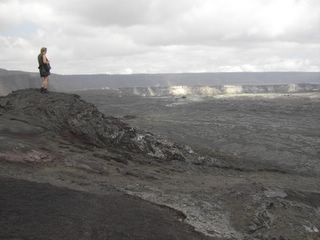The first time I went seawater sampling at Marguerite Bay, a penguin jumped clean out of the ice strewn waters and landed in our small orange inflatable. This was the Antarctic after all. Unperturbed by our laughter, it peered curiously around, presumably wondering what on earth we were doing lowering a bundle of sensors 500 meters down into the chilly depths. And well it might ask.
We were there to investigate the dramatic algal bloom that turns the waters of Marguerite Bay to a dense soup every summer. Here, on the coast of the great white continent, all the necessary nutrients are present for microscopic marine algae to thrive. As the spring dawn melts the sea’s lid of ice, daylight floods into the surface waters and a lush marine jungle flourishes. The water turns green as tiny plants happily photosynthesise away, changing the chemistry of the surrounding water as they do so.
My particular role was to find out how this slimy explosion of algal life changes the iodine in water. Now, while I admit to finding the chemical quirks of this charismatic element fascinating, I appreciate that the rest of the world might ask ‘why should we care?’
Firstly, iodine is an essential part of our diet – deficiency leads to goitre, stillbirths and impaired mental function. Insufficient iodine intake remains a major public health problem in many countries, and shockingly, is the number one cause of preventable brain damage in children1.
Secondly, iodine is an important player in the complex chemical reactions that occur in marine air. As a halogen, it is capable of destroying ozone in the swirling masses of the lower atmosphere, which in turn affects the ability of the air to cleanse itself of greenhouse gases. Iodine atoms can also cluster together, forming tiny seeds on which clouds can form. Because of these processes, the amount of iodine in the air can ultimately impact on the Earth’s climate.
In both cases, the iodine originates from the sea. Iodine gases escape from the surface of the ocean to join the chemical dance in the air, and some is blown onto land and incorporated into the terrestrial food chain. The mechanism of sea-air transfer, and the way this might be affected by climate change, remains a crucial missing link in our understanding of the iodine cycle. And here we open a Pandora’s box of shifting chemical forms and intimate relationships with phytoplankton.
Most of the iodine in seawater combines with oxygen to form iodate, enjoying a happy, stable, and thermodynamically predictable relationship. However, in the brightly lit gardens of the surface ocean, up to half of the iodine goes it alone, as the negatively charged iodide ion (analogous to chloride in common salt). Iodide is unstable, and not expected to form in seawater, so how did it get there? And how do these inorganic forms get converted to the volatile compounds that can cross the air-sea boundary?
When the going gets tough, marine chemists like to invoke a little biology to explain things. Marine algae have been shown to produce iodine-containing gases2, and tantalizing evidence suggests that they might also be to blame for the presence of iodide in surface waters.
And this is where I come in, bobbing about on a boat at 67 degrees south, fending off icebergs and penguins, and trying to demonstrate a link between iodide and algae. Alongside me is Dr Claire Hughes, looking at the production of iodine-containing gases during the algal bloom. Antarctica offers unique insights on the iodine cycle because, in the chilly waters of the South iodide levels are exceptionally low, but the atmospheric iodine signal is strong.
Back home comes the tricky bit - unraveling the interplay of biology, light and moving water masses. In the rather more mundane surroundings of the laboratory, we try to coerce jars of algae to reveal the secrets of their relationship with iodine. The picture that is slowly emerging is complex, and rarely what we expect, but one day I hope to fit my own little piece into the jigsaw that is the iodine cycle.
1. World Health Organisation Global Database on Iodine Deficiency (2004) Report: Iodine Status Worldwide, Geneva.
2. e.g. Manley & de la Cuesta (1997) Limnol. Oceanogr. 42, 142-147.










